As we all know electronic components are essentially important to be applied in various industries, including the computer industry, home appliances, etc.
Understanding the diverse types of electronic components is crucial for anyone delving into the realm of electronics.
In this comprehensive guide, we explore 10 different types of electronic components, shedding light on their functionalities, applications, and significance.
How Many Electronic Components Are There?
The number of electronic components available is vast and continually evolving with advancements in technology.
However, some of the most common electronic components number in the thousands and include resistors, capacitors, inductors, diodes, transistors, integrated circuits, sensors, switches, connectors, and more.
Each type of component serves specific functions within electronic circuits, contributing to the overall operation of electronic devices and systems. While it’s challenging to provide an exact count of all electronic components, their diversity and ubiquity demonstrate the breadth and depth of electronics technology.
Electronic Component Basics
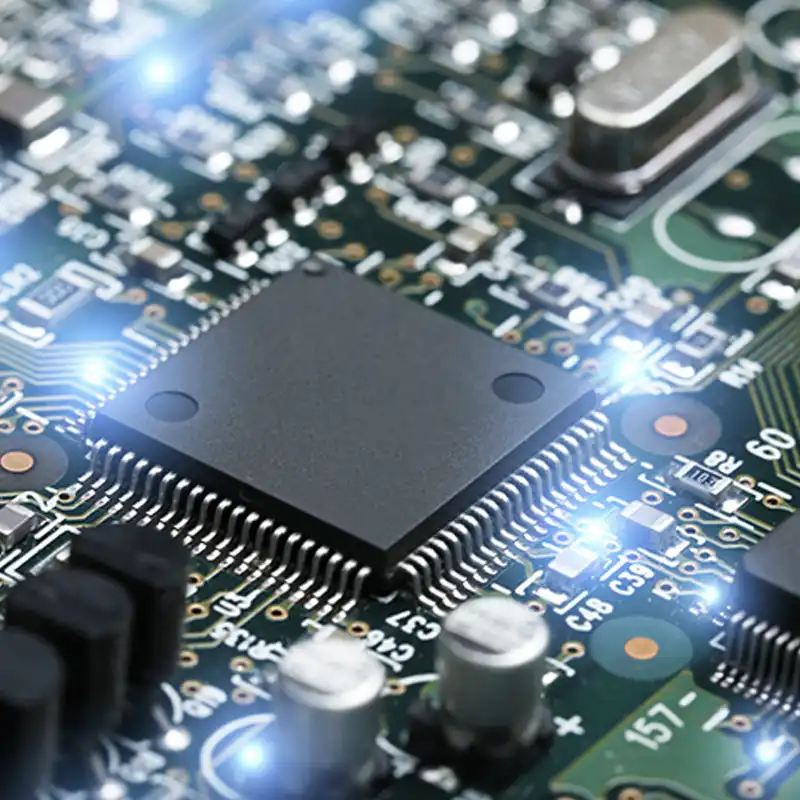
Electronic components are the building blocks of electronic circuits, allowing engineers and hobbyists to create a wide range of electronic devices.
These are just a few examples of electronic components, and there are many more specialized components used in various applications.
Here are some basic types electronic components commonly used in circuits:
Semiconductors: Powering Modern Electronics
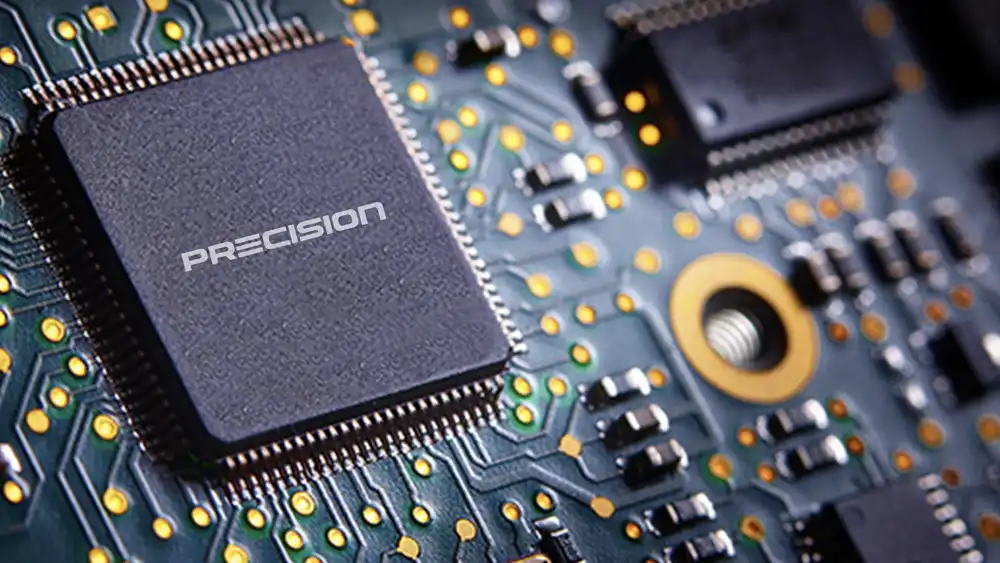
Semiconductors stand as the cornerstone of modern electronics, enabling the development of transistors, diodes, and integrated circuits. These components possess conductivity levels between conductors and insulators, offering precise control over electrical currents. With applications ranging from amplification to switching, semiconductors drive the functionality of various electronic devices, including computers, smartphones, and televisions.
Resistors: Regulating Electrical Flow
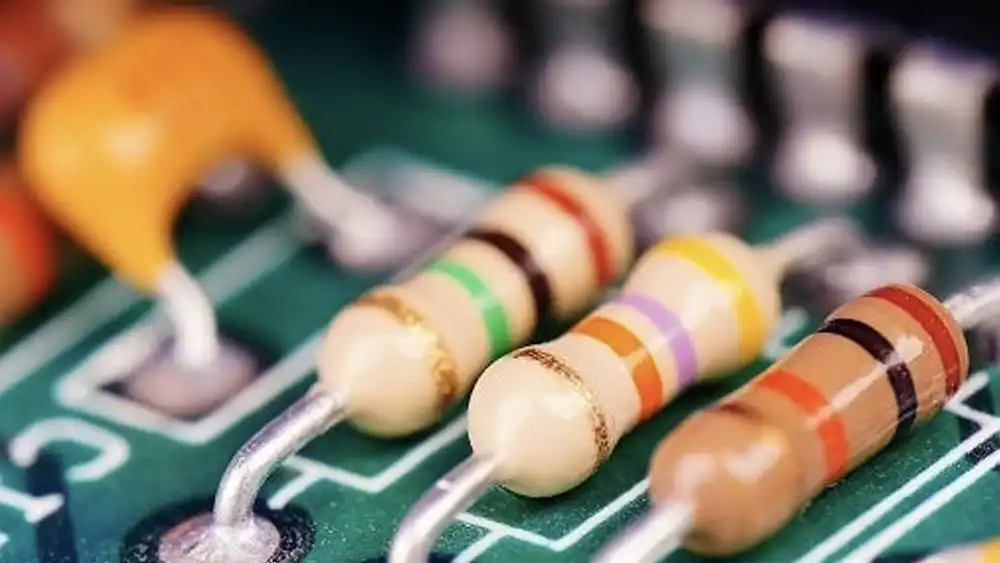
Resistors play a pivotal role in regulating electrical flow within circuits by impeding the passage of current. They are commonly utilized to adjust signal levels, divide voltages, and limit currents, ensuring the stability and safety of electronic systems. From miniature surface-mount resistors in consumer electronics to high-power resistors in industrial machinery, these components find widespread application across diverse sectors.
Capacitors: Storing and Releasing Electrical Energy
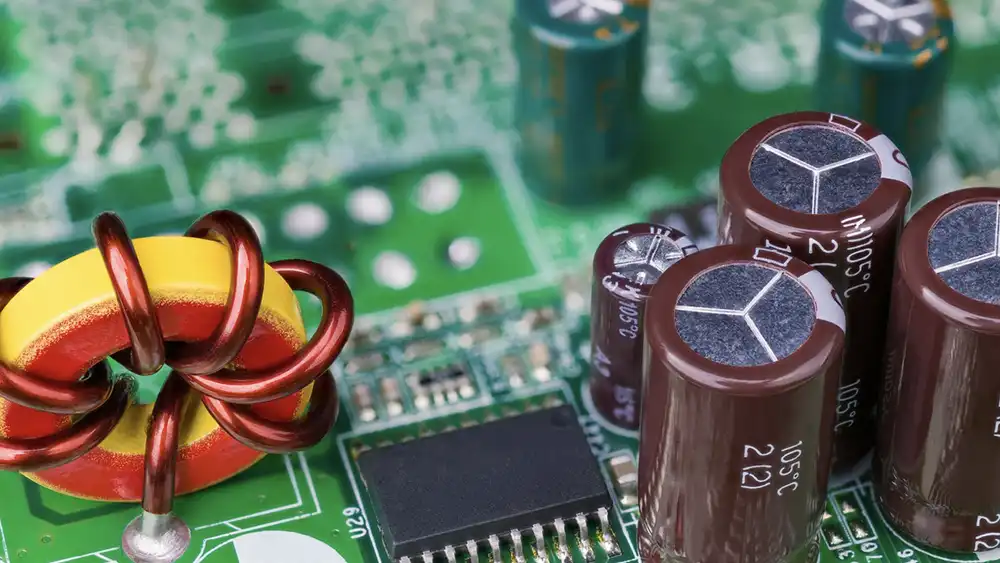
Capacitors serve as energy storage devices within electronic circuits, storing electrical energy in an electric field. They are instrumental in filtering noise, stabilizing voltage levels, and providing power backup in various electronic systems. Capacitors come in a myriad of types, including electrolytic, ceramic, and tantalum capacitors, each catering to specific application requirements with varying capacitance values and voltage ratings.
Inductors: Facilitating Energy Transfer
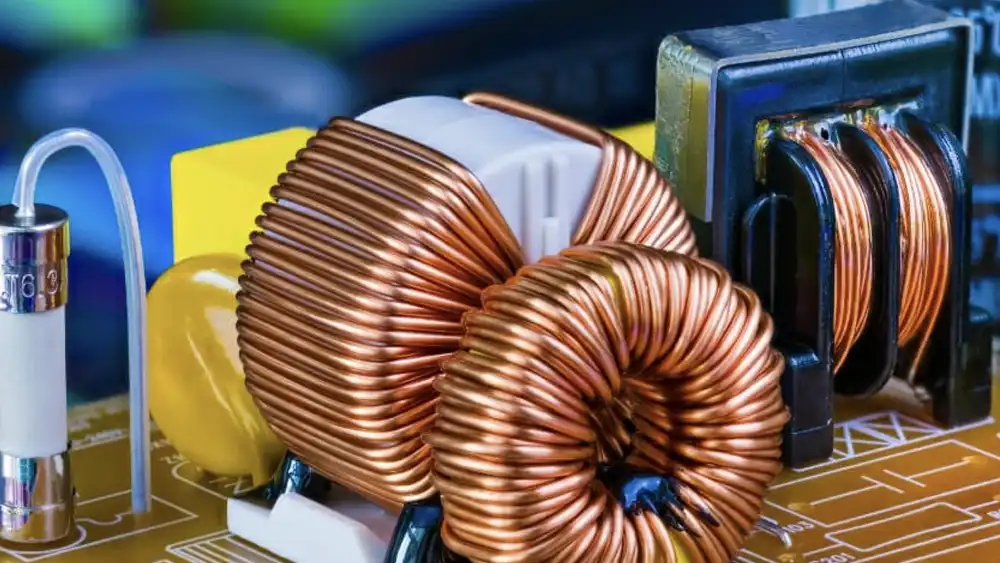
Inductors, also known as coils or chokes, facilitate the transfer of energy within circuits through electromagnetic induction. These components store energy in the form of a magnetic field when current flows through them, exhibiting properties such as inductance and self-resonance. Inductors find extensive use in applications requiring signal filtering, impedance matching, and energy storage, contributing to the efficiency and performance of electronic devices.
Diodes: Enabling One-Way Current Flow
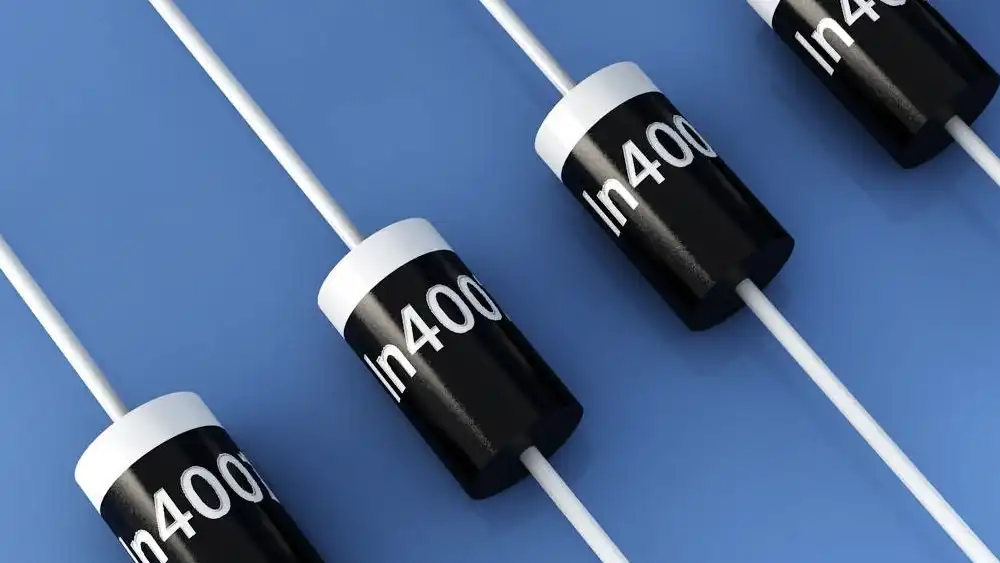
Diodes are semiconductor devices that permit current flow in only one direction while blocking it in the opposite direction. They serve various functions, including rectification, signal demodulation, and voltage regulation, essential for converting alternating current (AC) to direct current (DC) in electronic circuits. Diodes come in diverse types such as light-emitting diodes (LEDs), Schottky diodes, and zener diodes, each tailored to specific applications.
Transistors: Building Blocks of Electronic Devices
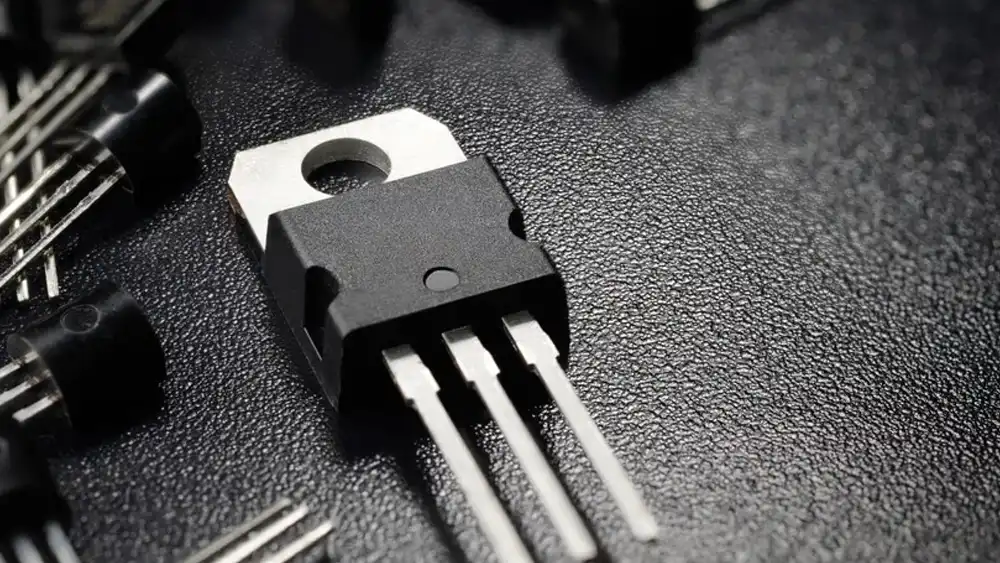
Transistors are fundamental building blocks of electronic devices, facilitating amplification, switching, and signal modulation. These semiconductor devices consist of three terminals—emitter, base, and collector—enabling precise control over current flow. With applications spanning from digital logic circuits to radio frequency amplifiers, transistors play a pivotal role in shaping the functionality and performance of modern electronic systems.
Integrated Circuits: Revolutionizing Electronics
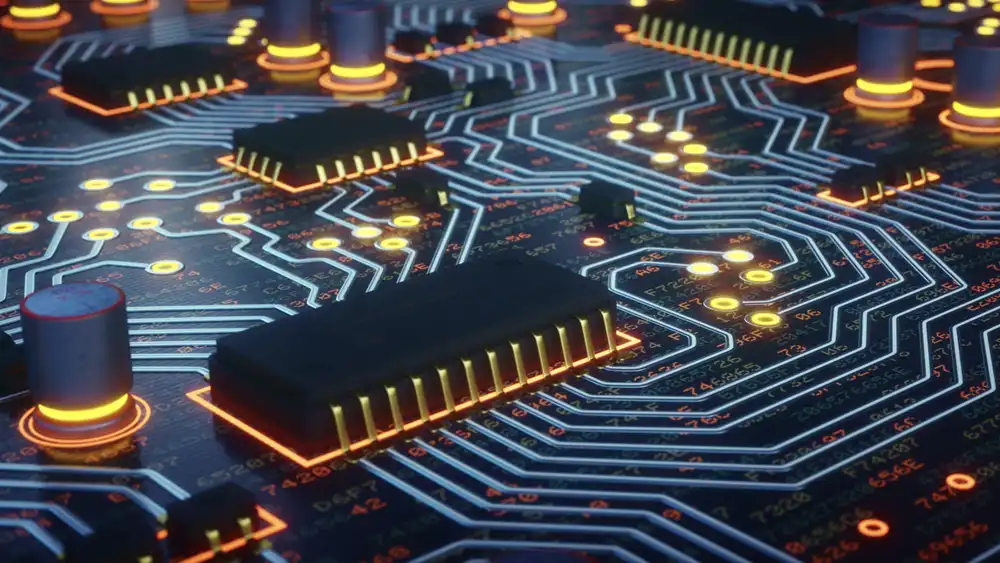
Integrated circuits (ICs) revolutionized the field of electronics by miniaturizing complex circuitry into a single semiconductor chip. These compact devices comprise numerous interconnected electronic components, including transistors, resistors, and capacitors, on a silicon substrate. Integrated circuits enable the development of powerful microprocessors, memory chips, and sensor arrays, driving advancements in computing, telecommunications, and automation.
Sensors: Bridging the Physical and Digital Worlds
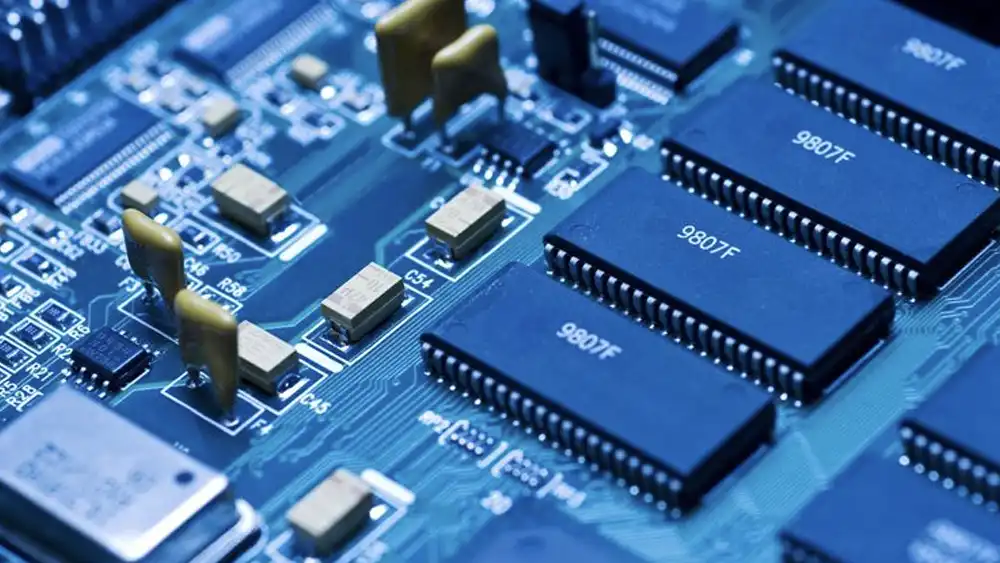
Sensors are electronic devices that detect and respond to physical stimuli, converting real-world phenomena into electrical signals. They play a pivotal role in monitoring environmental conditions, measuring physical parameters, and enabling feedback control in electronic systems. From temperature sensors and motion detectors to pressure transducers and proximity sensors, the diverse array of sensors facilitates a myriad of applications across industries.
Connectors: Establishing Electrical Interfaces
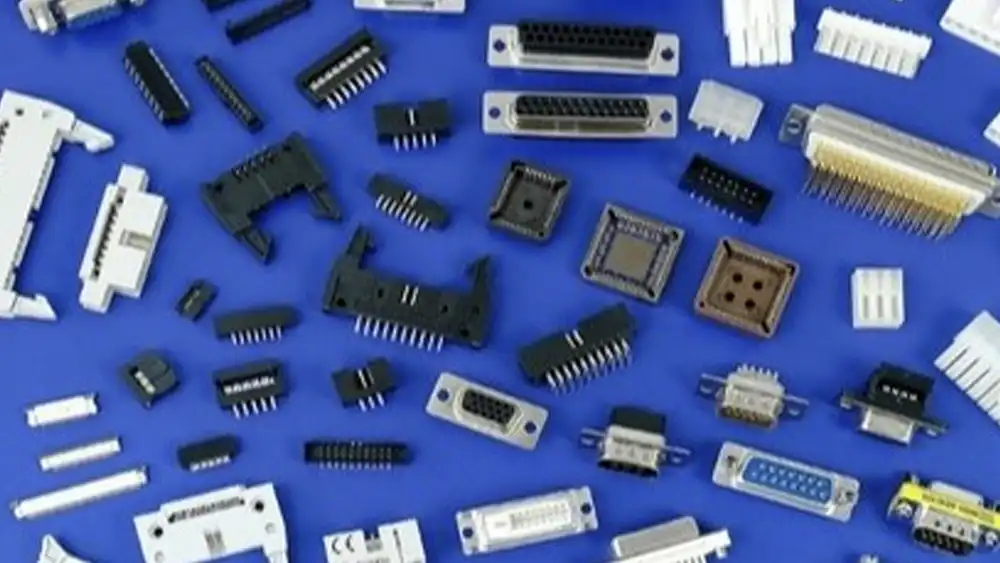
Connectors serve as the interface between electronic devices, enabling the transfer of electrical signals, power, and data. These electromechanical components come in various forms, including plugs, sockets, and terminals, facilitating secure and reliable connections. Connectors play a crucial role in interconnecting circuit boards, peripheral devices, and external modules, ensuring seamless communication and functionality in electronic systems.
Types of Active Components in Electronics
Active components are electronic devices that are capable of amplifying, controlling, or generating electrical signals. Unlike passive components, which do not require an external power source to function, active components rely on an external power supply to operate. Here are some common types of active components used in electronics:
- Transistors:
- Bipolar Junction Transistor (BJT): BJTs are three-terminal devices made of semiconductor material. They can amplify or switch electronic signals. BJTs come in two main types: NPN and PNP.
- Field-Effect Transistor (FET): FETs are also three-terminal devices, but their operation is based on the voltage applied to one of the terminals, called the gate. FETs are widely used in amplifiers, switches, and oscillators.
- Operational Amplifiers (Op-Amps):
- Op-amps are high-gain voltage amplifiers with two input terminals (inverting and non-inverting) and one output terminal. They are commonly used in signal conditioning, filtering, and mathematical operations such as addition, subtraction, and integration.
- Integrated Circuits (ICs):
- ICs are miniaturized electronic circuits consisting of interconnected active and passive components fabricated on a single semiconductor chip. They can perform various functions such as amplification, signal processing, logic operations, and memory storage.
- Examples of ICs include microcontrollers, microprocessors, operational amplifier ICs, and analog-to-digital converter ICs.
- Diodes:
- While diodes are primarily passive components, some types, such as the Gunn diode and the tunnel diode, can exhibit active behavior under certain conditions. For example, Gunn diodes are used in microwave oscillators, and tunnel diodes are used in high-frequency applications and switching circuits.
- Thyristors:
- Thyristors are semiconductor devices with four layers of alternating P-type and N-type material. They are used as switches in power control circuits, such as motor drives, lighting control, and power supplies. Examples include silicon-controlled rectifiers (SCRs) and triacs.
- Voltage-Controlled Oscillators (VCOs):
- VCOs are electronic circuits that generate an oscillating output voltage whose frequency can be controlled by an input voltage. They are used in frequency synthesizers, phase-locked loops, and modulation circuits.
Here’s a table summarizing the types of active components:
| Active Component | Description |
|---|---|
| Transistors | Amplify or switch electronic signals. |
| Operational Amplifiers | High-gain voltage amplifiers with versatile applications. |
| Integrated Circuits | Miniaturized electronic circuits on a single semiconductor chip, performing various functions. |
| Diodes | Some types exhibit active behavior under certain conditions, used in specialized applications. |
| Thyristors | Semiconductor switches used in power control circuits. |
| Voltage-Controlled Oscillators | Generate oscillating output voltage with frequency controlled by an input voltage. |
Understanding the characteristics and applications of these active components is crucial for designing and building electronic circuits for various purposes.
Types of Passive Components in Electronics
Passive components are fundamental elements in electronic circuits that do not require an external power source to perform their basic functions. They include resistors, capacitors, inductors, and various types of sensors. Here’s an explanation of the different types of passive components:
- Resistors: Resistors are used to restrict the flow of electric current in a circuit. They are characterized by their resistance, which is measured in ohms (Ω). Resistors are commonly used for voltage division, current limiting, and biasing circuits.
- Capacitors: Capacitors store and release electrical energy. They consist of two conductive plates separated by an insulating material called a dielectric. Capacitors are characterized by their capacitance, measured in farads (F), and they are used for filtering, coupling, timing, and energy storage in circuits.
- Inductors: Inductors store energy in a magnetic field when current flows through them. They consist of a coil of wire wound around a core material. Inductors are characterized by their inductance, measured in henrys (H), and they are used for filtering, energy storage, and inductive coupling in circuits.
- Transformers: Transformers are a type of inductor consisting of two or more coils of wire wound around a core. They are used to transfer electrical energy between circuits through electromagnetic induction. Transformers are commonly used for voltage conversion, impedance matching, and isolation in power supply circuits.
- Resistor Networks: Resistor networks are a collection of resistors packaged together in a single component. They are used to simplify circuit design and save space on the circuit board. Resistor networks are commonly used in applications such as voltage dividers, biasing networks, and termination resistors.
- Capacitor Arrays: Capacitor arrays are a collection of capacitors packaged together in a single component. They are used to provide multiple capacitance values in a compact form factor. Capacitor arrays are commonly used in applications such as filtering, decoupling, and timing circuits.
- Varistors: Varistors are voltage-dependent resistors that exhibit nonlinear behavior. They are used to protect electronic circuits from overvoltage conditions by clamping excessive voltage levels. Varistors are commonly used in applications such as surge protection and transient suppression.
- Thermistors: Thermistors are temperature-sensitive resistors that change resistance with temperature. They are used for temperature sensing and compensation in electronic circuits. Thermistors are commonly used in applications such as temperature measurement, control, and compensation.
- Light-dependent Resistors (LDRs): LDRs are light-sensitive resistors that change resistance in response to changes in ambient light levels. They are used for light sensing and control in electronic circuits. LDRs are commonly used in applications such as streetlights, camera exposure control, and automatic brightness adjustment.
Here’s a table summarizing the types of passive components in electronics:
| Passive Component | Description |
|---|---|
| Resistors | Restrict the flow of electric current in a circuit |
| Capacitors | Store and release electrical energy |
| Inductors | Store energy in a magnetic field when current flows through them |
| Transformers | Transfer electrical energy between circuits through electromagnetic induction |
| Resistor Networks | Collection of resistors packaged together in a single component |
| Capacitor Arrays | Collection of capacitors packaged together in a single component |
| Varistors | Voltage-dependent resistors that protect circuits from overvoltage conditions |
| Thermistors | Temperature-sensitive resistors that change resistance with temperature |
| Light-dependent Resistors (LDRs) | Light-sensitive resistors that change resistance in response to changes in ambient light levels |
Understanding the characteristics and applications of these passive components is essential for designing and troubleshooting electronic circuits.
Active Electronic Components Vs Passive
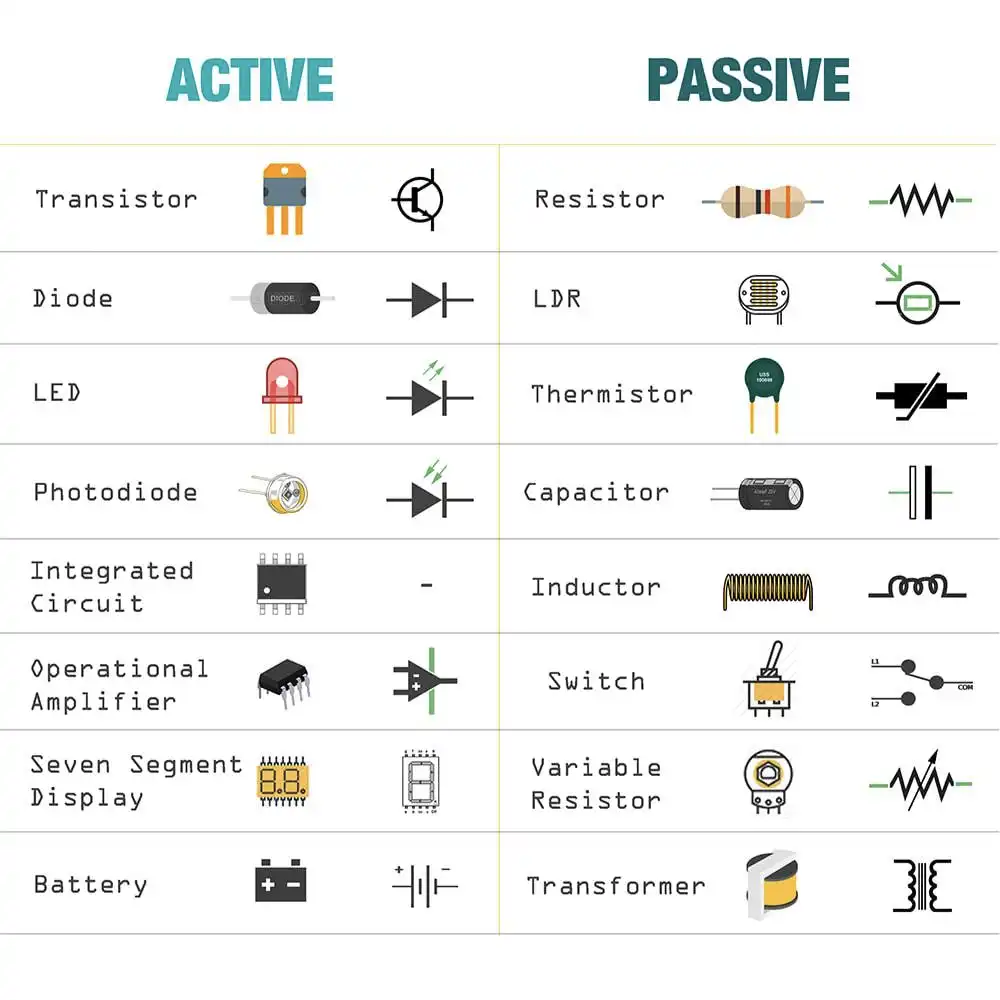
| Active Components | Passive Components |
| Light Emitting Diode (LED) | Resistor |
| Transistor | Capacitor |
| Integrated Circuit (IC) | Inductor |
| Battery | Circuit Breaker |
| Relay (Can also be used as Passive) | Fuse |
| Diode | Switch |
| Solar Cell | Transformer |
| Current Sensor | Electrical Wires & Power Cables |
| SMD Components | Motor |
Conclusion
In conclusion, the world of electronic components encompasses a diverse array of components, each contributing uniquely to the functionality and performance of electronic devices. From semiconductors and resistors to sensors and connectors, understanding the roles and applications of these components is essential for anyone venturing into the field of electronics. By unraveling the intricacies of electronic components, we pave the way for innovation and technological advancement in the digital age.
FAQs (Frequently Asked Questions)
What are the most commonly used types of electronic components?
The most commonly used types of electronic components include resistors, capacitors, diodes, transistors, and integrated circuits.
How do semiconductors contribute to the functionality of electronic devices?
Semiconductors enable precise control over electrical currents, facilitating amplification, switching, and signal processing in electronic devices.
What role do sensors play in electronic systems?
Sensors detect and respond to physical stimuli, converting real-world phenomena into electrical signals for monitoring, measurement, and control purposes.
Why are connectors important in electronic devices?
Connectors establish electrical interfaces between devices, enabling the transfer of electrical signals, power, and data essential for communication and functionality.
Can you provide examples of electronic components used in everyday devices?
Electronic components such as resistors, capacitors, and transistors are integral parts of everyday devices like smartphones, computers, and household appliances.
How do integrated circuits contribute to advancements in technology?
Integrated circuits miniaturize complex circuitry into a single chip, enabling the development of powerful microprocessors, memory chips, and sensor arrays, driving advancements in computing and telecommunications.